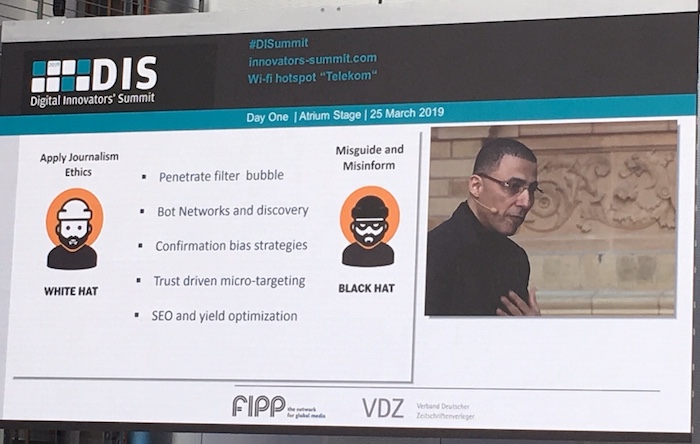
"We are living in a post-truth era where objective facts are less influential in shaping public opinion than appealing to emotions and personal beliefs," said Yaser Bishr, executive director of digital at Al Jazeera Media Network, speaking at the Digital Innovators’ Summit (25 March 2019).
To help journalists get the facts across, he suggested the media should use the same techniques as social platforms.
"I don’t think that appealing to emotions and beliefs is negative. There is still room for facts but there is a large segment of the population that is being left out. We have a responsibility as news organisations to inform them," he explained.
But there is a catch: if the media starts blurring the lines between facts and beliefs, truth and emotions, they can also be perceived as manipulators. This is where ethical considerations - black hat versus white hat if you will - make the balance tip.

"We should open our door to discussion, invite the other side to share their opinions and have a civil discussion," said Bishr, while acknowledging that bringing controversial opinions in front of audiences not willing to listen can be tricky.
"The fact that Sputnik was the second most influential medium in the Italian elections, that’s what’s most dangerous at the moment. And that the 2016 US election was largely dominated by appealing to the fear of brown people — we cannot ignore this reality.
"Don’t you think it’s time for journalists to try different tools?" he asked, adding that it is crucial for journalists to understand how to reach the right people via social posting as public trust in the traditional media outlets is plummeting.
To help newsrooms with the mission, he devised five tools for journalists to use to affect audience: penetrate filter bubbles; use bot networks and discovery; prepare confirmation bias strategies, invest in trust-driven micro-targeting; and use SEO and yield optimisation.
For instance, he explained that there is little difference between using a Facebook boost to target a specific audience with news content and using bots to diffuse factually accurate content in the online communities.
"Micro-communities form around social media influencers," said Bishr.
"These influencers are the ones who push for the wall or against migrant caravans from Mexico. They are affecting public opinions."
To use this to their advantage, Bishr suggested news organisations identify micro-influencers and collaborate with them on diffusing verified facts, rather than just watching them spreading misinformation and debunking it on their own platforms.
Although the media cannot change the algorithms that govern social networks, there is one thing they can do to inspire change.
"Mass media often demonises the other side. Are newspapers trying to have a civil conversation with people who wouldn’t typically buy or read their content, seek their opinion and expose it to their loyal audience? Not really."
However, engaging with audiences who do not bring any revenue can be a pure financial loss for news organisations that are already strapped for cash.
"But there is still a mission for journalism and that’s the balance we need to strike. It is about reporting facts. The other part of it now is making sure the right audiences are going to get them.
"If we continue to be only revenue-driven, we’ll end up focusing on pop news and listicles. The solution is remembering to report the facts and penetrate the communities that need to know the truth to form an opinion," he concluded.
Free daily newsletter
If you like our news and feature articles, you can sign up to receive our free daily (Mon-Fri) email newsletter (mobile friendly).
Related articles
- Journalists are happy to be disconnecting from platforms, should news organisations be worried?
- Protecting journalists on social media, with Valérie Bélair-Gagnon
- What will your audience want in the future?
- New resources to help journalists fight elections misinformation
- 15 free sources of data on the media industry









